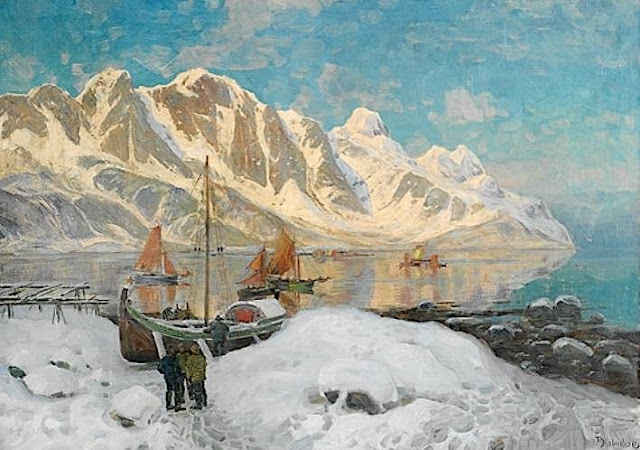PEDER BALKE (1804 -1887)
North Cape (307m - 1,007 ft)
Norway
The cliff
North Cape (307m - 1,007 ft), Nordkapp in Norwegian, named by the Englishman Steven Borough, captain of the Edward Bonaventure, which sailed past in 1553 in search of the Northeast Passage, is a cape on the northern coast of the island of Magerшya in Northern Norway. The cape is in Nordkapp Municipality in Finnmark county, Norway. The European route E69 highway has its northern terminus at North Cape, since it is a popular tourist attraction. The cape includes a 307-metre (1,007 ft) high cliff with a large flat plateau on top where visitors can stand and watch the midnight sun or the views of the Barents Sea to the north. A new visitor centre was built in 1988 on the plateau with panoramic views, a cafй, restaurant, post office, souvenir shop, and a so-called super video cinema.
The steep cliff of North Cape is located at 71°10′21″N 25°47′04″E, about 2,102.3 kilometres (1,306.3 mi) from the North Pole. It is often referred to as the northernmost point of Europe. However, the neighbouring Knivskjellodden point, just to the west actually extends 1,457 metres (4,780 ft) further to the north. Furthermore, both of these points are situated on an island; the northernmost point of mainland Europe is located at Cape Nordkinn (Kinnarodden) which lies about 5.7 kilometres (3.5 mi) further south and about 70 kilometres (43 mi) to the east. That point is located near the village of Mehamn on the Nordkinn Peninsula. The northernmost point of Europe including islands is several hundred miles further north, either in Russia's Franz Josef Land or Norway's Svalbard archipelago, depending on whether Franz Josef Land is considered to be in Europe or in Asia.
The North Cape is the point where the Norwegian Sea, part of the Atlantic Ocean, meets the Barents Sea, part of the Arctic Ocean. The midnight sun can be seen from 14 May to the 31st of July.
The sun reaches its lowest point from 12:14 - 12:24 a.m. during those days.
The North Cape is reached by European route E69 highway through the North Cape Tunnel, an undersea tunnel connecting the island of Magerшya to the mainland. The EuroVelo bicycle route EV1 runs from North Cape to Sagres, Portugal—a 8,196 kilometres (5,093 mi) distance by land and sea.
Regular buses run from the nearby town of Honningsvеg to the North Cape (36 kilometres (22 mi)), and coaches meet the many cruise ships that call at the port of Honningsvеg. The nearest airport is Honningsvеg Airport, Valan.
During winter season, it is also possible to visit North Cape, however the last stretch of road is only open for convoy driving at fixed hours. The road all the way through Norway up to North Cape is kept open during winter and is accessible to regular vehicles with some specific winter precautions being required to deal with the hard snow and wind conditions that may occur in winter. Before this, E69 was the only winter closed E road in Europe.
The painter
Peder Balke is a Norwegian painter that was even barely known in his home country, until recently. He didn’t encounter success during his lifetime. Having difficulties to sell his paintings, he abandoned his career to focus on social projects and politics but he continued to paint for his own pleasure. Once delivered from the pressure of making a living from his paintings, his style changed to become more personal, more modern.
During the summer 1832, Peder Balke, who was in love with the Norwegian landscapes, decided to go and seek for its most remote, its most desolate and its most distant points by sailing up the west coast of Norway as far as he could go. He went up to the inhospitable and barely accessible far-northern region of Finnmark. He reached the North Cape, the northernmost part of Norway, which was even more impressive at that time because it was the further north you could go, the final limit to knowledge and exploration – beyond it lies nothing (explorers only reached the North Pole in the late 1900s, two decades after his death).
Peder Balke wrote in his memoirs: “I can’t begin to describe how elated I was at having seen and re-tread the land, once again, after satisfying my deep longing to see the northern provinces. No easier is it for me to pen my thoughts on which sublime and mesmerizing impressions the wealth of natural beauty and unrivaled settings leave upon the mind of an observer. These impressions not only overwhelmed me for a brief moment, but they, too, influenced my entire future since I never yet, neither abroad nor other places in our country, have had the occasion to gaze at something so awe-inspiring and exciting as that which I observed during this journey to Finnmark. Unsurpassed in the norther provinces is the beauty of nature, while humans – nature’s children – play but a minor role, in comparison”.
The 1832 journey had a momentous effect upon his development as an artist; the eerie, isolated, dramatic and gloomy Arctic landscapes became a leitmotiv as he continued to paint them from his memory for the rest of his life.
Peder Blake’s early paintings are quintessentially romantic, the product of a man awed by nature, overwhelmed by the often-horrifying beauty of his own land.
Long forgotten, Peder Balke is today increasingly recognized as an important precursor of modern painters.























